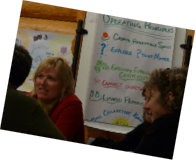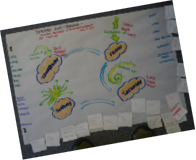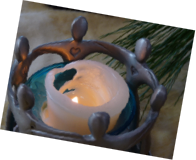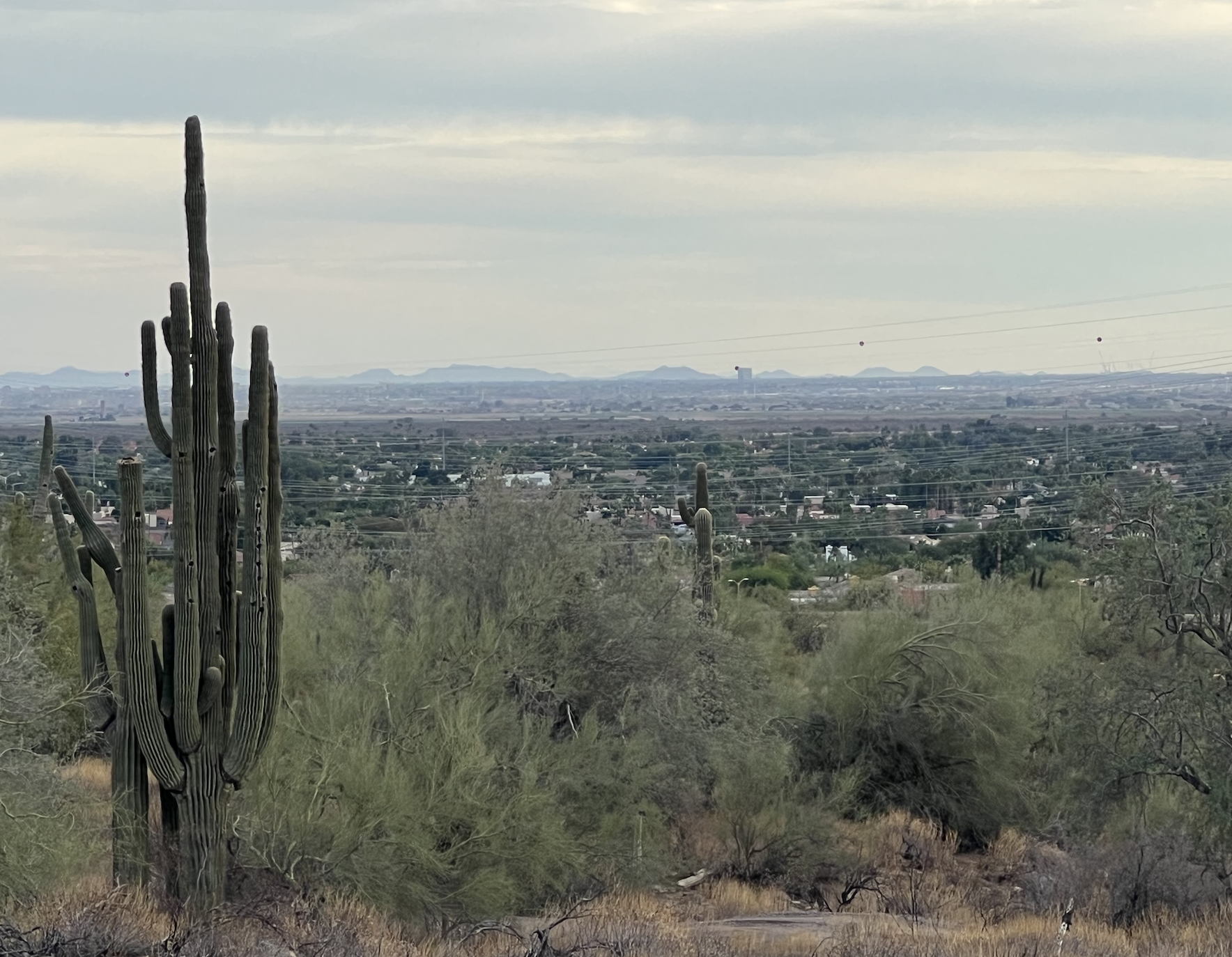I was in Rosendale, New York in early November at the Lifebridge Sanctuary. With a co-hosting team of Nancy Fritsche Eagan, Martin Siesta, Silas Lusias, and Kelly McGowan, we were close to completing the third of three days for an Art of Hosting training. It was going well. We had just completed a lovely and deep circle hosted by participants. The weave of that group was feeling particularly close.
I’ve hosted Art of Hosting trainings now over many years. Open enrollment trainings like the one in New York. Client engagements also when there is a more specific purpose or strategy to be developed. Hundreds of cafes, circles, appreciate approaches, and open space working groups. The simple know-how of any of these methods and others are really helpful skills.

During the break in New York, I found myself getting insights about a question I’ve been asking for a few years. Hosting what? Yes, hosting what? I know we call it “Hosting Conversations that Matter.” Yet, when done well, it seems like much more is happening. Like hosting conversations becomes a doorway to something deeper and more lasting. What is that? That’s what I want to learn more about. And practice with deliberateness. I know I’m not speaking of something entirely new — many of us know there is something more and have been trying to name it. In her poem, Prospective Immigrants Please Note Adrienne Rich has some words for this, going through doorways, that I love. “If you go through there is always the risk of remembering your name.” Perhaps it is the remembering of our names, purpose beneath the purpose, connection beneath the connection, that is so compelling.
So, in New York I got some clarity. Some on the “what to expect from an Art of Hosting.” A sense of “remembering the future.” Because I was seeing it play out again. And because it was a reaffirmation for any part of me that thinks, “this won’t work this time.” It is the kind of stuff I would want to share with any client or community group thinking of calling an Art of Hosting. The “what is likely to happen” through the doorway of conversations that matter.
Remembering the Future — What is Really Likely to Happen at an Art of Hosting Training
1. Though the group will start as strangers, there will be a strong sense that we have met before. It happens all of the time. After a day of working together, and it feels like we’ve been together for a lot longer than that (in an appreciated way), people start to feel that surely they have met before. It’s almost unfathomable that the group could have started only one or two days ago. This says something, by the way, about when clients are wondering if it is really different to meet over several days together rather than just a series of two-hour meetings.
2. There will be a strong sense of community. We will remember what community can be in the best of ways. We’ll anticipate being together in the mornings, the days, and the nights. People will offer some of what they can. They’ll be able to ask for the help that they need. And we’ll be deliberate about honoring beginning and ending times. Oh, and yes, as it is in any great community, we will tell stories. That’s how we will learn in our conversations together. That’s how we will show up. And one last thing, people will share things about themselves that they normally wouldn’t feel comfortable sharing. You’ll know you’re there when someone speaks beginning with, “Well, I didn’t think I would say this, but I feel I can and need to tell this story….” Deeply personal weaving into the professional.
3. People will be creative. It seems to happen when we combine three things together. First, learning. Through the maps, models, teachings, experiences. Second, relationships. Through telling stories and asking questions with each other, people will
 want to work together. Rather than the default isolation, people will seek each other out because they see each other as resources, friends, and allies in creativity. And third, people will want to work on projects. They will shift from what World Cafe co-founder Juanita Brown calls “if only or yah, but” to “what if…” to “why not!” Beautiful to see.
want to work together. Rather than the default isolation, people will seek each other out because they see each other as resources, friends, and allies in creativity. And third, people will want to work on projects. They will shift from what World Cafe co-founder Juanita Brown calls “if only or yah, but” to “what if…” to “why not!” Beautiful to see.
4. The group will come to see and want to see through a lens of beauty. They’ll adopt beauty as a criteria for their work, interactions, and offerings. Beauty in the questions they offer. Beauty in the physical set up of the room. Beauty in the individuals that are in the room. Beauty in themselves. I love this point in time. Someone tidies the circle. Brings in a flower from outside. Offers a next level of harvest. It is when imperfections are welcomed and even celebrated because they are welcomed from whatever level of beauty is in the participants. It is an exquisite moment from the standpoint of appreciative approaches. And it is as though we put on new glasses and see anew something that has been there all along. Resonance of beauty.
5. People will be courageous. People will come to feel a strong sense of “being bigger.” I don’t experience it as ego inflation. It is more simply what becomes available as people settle in to the next level of working on their projects, working with other colleagues, and working from a shifted and renewed clarity of values and world view. It is magical when the complex becomes simple. Not reductive simple. Principled simple. Energetically-clear simple. What a thing to see us awaken to our courage to be clear and get to work from that place.
I’ve seen each of these five things happen over and over again. In myself. In others. In people young and old. In people from all sectors of work, industry, and community. I think I’ve even hesitated to speak it sometimes, concerned it would sound falsely ideal. I remember from some of the early trainings that I co-hosted, feeling my inner cynic, feeling that surely this one would not be as successful as the last one. Or that it would flop. I know flopping is possible. Yet, I have not seen it. Rather, I have seen more people eager to come further in to a community of practice. My clarity and courage have grown. And also my trust in the form that is the Art of Hosting and the teams that gather together to host it.
So, back to the original basic question — hosting what? Let’s return to that. If the above “remember the futures” happen so noticeably, then what might we point to that underlies these delicious (and productive) outcomes? What might we come to learn and own and deepen as a contribution of our time to convening people and systems so that we can do and offer what we most care about?
Hosting What?
- Hosting what? Hosting consciousness. Rather, I believe, what happens is that we are hosting a field of consciousness. Consciousness at the next level. Shared consciousness that stimulates meaningful action. Though “conversations that matter,” “conversational leadership,” “participative leadership,” “stakeholder engagement” and anything else we want to call it are powerful, they become transformative when next level of consciousness arrives. In individuals and in the group. My grandmother used to tell me as a young boy that most humans use only 3% of their brain cells (this might have been gentle chastising for something I did that was dumb, but I remember it as insight). Next level consciousness kicks in when we use more of those brain cells, and heart cells, and intuitive cells. It is the point when individuals and teams shift from stuck points into immense choices of possibility.
- Hosting what? Hosting wellness. As colleague and friend, Meg Wheatley reminds me, “if you want a system to be healthy, connect it to more of itself.” Conversations create connection. Stories create connection. Questions create connection. And even more significantly, they all create wellness. It isn’t a stretch to compare wellness in individuals to wellness in systems. When we are well individually, we have more capacity. If I am not well physically, or emotionally, or spiritually, everything changes. Oh, and yes, I get that wellness is a process, an experience — not a destination. I would also go one step further on wellness. It comes from invitations to deliberately create together. We’ve all been with teams before where the “problem” has become so monstrous that it can’t be unravelled any further. Frustration. Anger. Fear. Withdrawal. Apathy. Trying to see precise cause in such can feel like such a dead end. However, to invite a team to focus on creating — creating what they care about, yes with awareness and witnessing of the past — this is one of the best
 ways I know to host wellness.
ways I know to host wellness.
- Hosting what? Hosting wholeness. This builds on hosting wellness. In many spiritual traditions, the fundamental need for human beings is to return to wholeness. Release the world view, paradigm, and unconscious habit of separateness. Reclaim, or remember, the fundamental identity of together, of no-separation. In organizations this is often reintegrating from silo departments or functions to a holistic view of shared information and collaboration. It is the daring shift from an imposed neat-and-tidy world view of linear relations, to a more messy, yet flourishing experience of collaboration and collective action. Messy, yet real. Whole. I’ve heard many people at Art of Hosting trainings, as well as in client meetings say, with astonishment and appreciation, “this group process feels like therapy.” They speak it a bit hesitantly — we’re not supposed to be here for therapy. It isn’t offered as therapy. Not planned. Not delivered that way. But it is what arises. It is what emerges. Not group therapy. That is not my interest, nor my expertise. But group wellness and wholeness that emerges from simple process.
- Hosting what? Resonance. Earlier this summer Teresa Posakony and I led several interactive processes at the Institute of Noetic Sciences (IONS) Bi-Annual International Conference. One was following Edgar Mitchell, former Apollo Astronaut and founder of IONS. He said something that sticks with me. “Resonance is nature’s way of transferring information.” Resonance. Vibrancy. Frequency. Not limited to words. It is to most an invisible quality. An invisible measure. In a measurement culture largely defined by “if you can’t measure it, it doesn’t count.” Thankfully, to the IONS community in particular, there is significant research helping to make resonance visible and what we naturally turn to.
So, why share all of this? I get excited when I turn my attention to hosting consciousness, wellness, wholeness, and resonance. It works. It makes the outcomes and the process richly effective. By doing so, I feel immense freedom that welcomes varied approaches to conversational leadership. And to play. And to community. And to silence. Hosting consciousness, wellness, wholeness, and resonance welcomes me and others to work in the expansive magic that grows from a foundation of process methodologies. It frees me from preoccupation with form. It turns me to the next frontier of group work that can make a difference.
It gives me courage to think that some time in the future, I fully suspect we will reflect back on the days when we didn’t give attention, or know how to give attention to fields of consciousness, wellness, wholeness, and resonance. When it wasn’t common place. I like to think we’ll smile. Perhaps we will be naming next new frontiers then.



 ways I know to host wellness.
ways I know to host wellness.